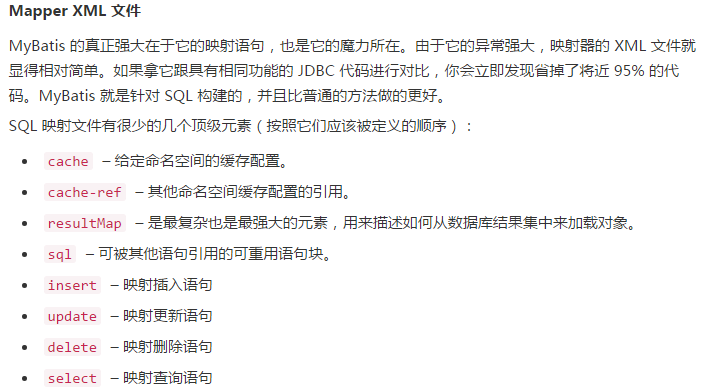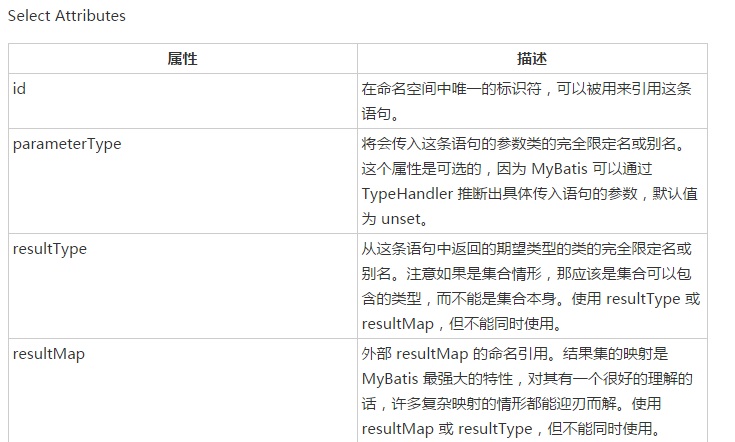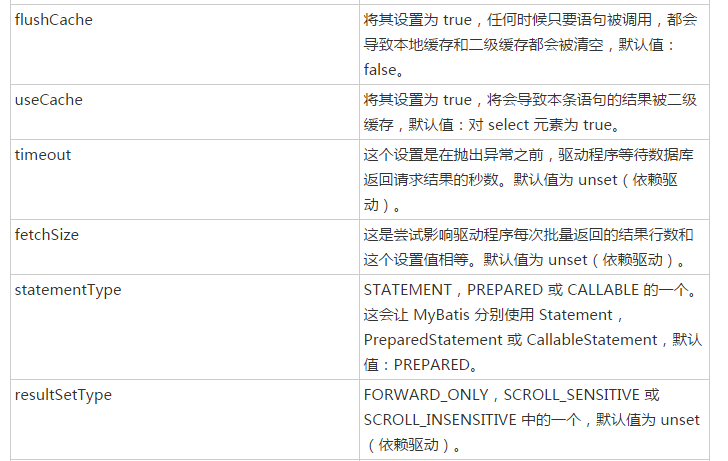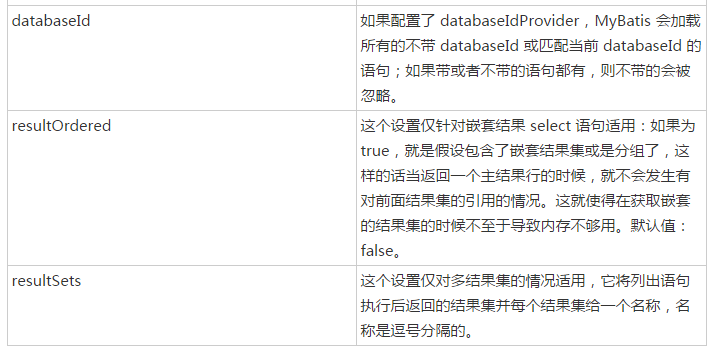mybatis源码配置文件解析之五:解析mappers标签(解析XML映射文件)
在上篇文章中分析了mybatis解析<mappers>标签,《mybatis源码配置文件解析之五:解析mappers标签》重点分析了如何解析<mappers>标签中的<package>子标签的过程。mybatis解析<mappers>标签主要完成了两个操作,第一个是把对应的接口类,封装成MapperProxyFactory放入kownMappers中;另一个是把要执行的方法封装成MapperStatement。
一、概述
在上篇文章中分析了<mappers>标签,重点分析了<package>子标签,除了可以配置<package>子标签外,在<mappers>标签中还可以配置<mapper>子标签,该子标签可以配置的熟悉有resource、url、class三个属性,解析resource和url的过程大致相同,看解析resource属性的过程。
下面看部分代码,
if (resource != null && url == null && mapperClass == null) {
ErrorContext.instance().resource(resource);
InputStream inputStream = Resources.getResourceAsStream(resource);
XMLMapperBuilder mapperParser = new XMLMapperBuilder(inputStream, configuration, resource, configuration.getSqlFragments());
/**
* 处理mapper文件和对应的接口
*/
mapperParser.parse();
}
可以看到调用了XMLMapperBuilder的parse方法,
public void parse() {
if (!configuration.isResourceLoaded(resource)) {
//1、解析mapper文件中的<mapper>标签及其子标签,并设置CurrentNamespace的值,供下面第2步使用
configurationElement(parser.evalNode("/mapper"));
configuration.addLoadedResource(resource);
//2、绑定Mapper接口,并解析对应的XML映射文件
bindMapperForNamespace();
}
parsePendingResultMaps();
parsePendingCacheRefs();
parsePendingStatements();
}
从上面的代码中可以看出首先解析resource资源说代表的XML映射文件,然后解析XML;映射文件中的namespace配置的接口。
二、详述
通过上面的分析知道,解析resource配置的XML映射文件,分为两步,第一步就是解析XML映射文件的内容;第二步是解析XML映射文件中配置的namespace属性,也就是对于的Mapper接口。
1、解析XML映射文件
看如何解析XML映射文件内容,也就是下面的这行代码,
configurationElement(parser.evalNode("/mapper"));
看具体的实现,
/**
* 解析XML映射文件的内容
* @param context
*/
private void configurationElement(XNode context) {
try {
//获得namespace属性
String namespace = context.getStringAttribute("namespace");
if (namespace == null || namespace.equals("")) {
throw new BuilderException("Mapper's namespace cannot be empty");
}
//设置到currentNamespace中
builderAssistant.setCurrentNamespace(namespace);
//解析<cache-ref>标签
cacheRefElement(context.evalNode("cache-ref"));
//二级缓存标签
cacheElement(context.evalNode("cache"));
parameterMapElement(context.evalNodes("/mapper/parameterMap"));
resultMapElements(context.evalNodes("/mapper/resultMap"));
sqlElement(context.evalNodes("/mapper/sql"));
//解析select、insert、update、delete子标签
buildStatementFromContext(context.evalNodes("select|insert|update|delete"));
} catch (Exception e) {
throw new BuilderException("Error parsing Mapper XML. The XML location is '" + resource + "'. Cause: " + e, e);
}
}
上面方法解析XML映射文件的内容,其中有个和二级缓存相关的配置,即<cache>标签。那么xml映射文件可以配置哪些标签那,看下面,

在XML映射文件中可以配置上面的这些标签,也就是上面方法中解析的内容。重点看解析select、update、delete、select。也就是下面这行代码
//解析select、insert、update、delete子标签
buildStatementFromContext(context.evalNodes("select|insert|update|delete"));
其方法定义如下,
private void buildStatementFromContext(List<XNode> list) {
if (configuration.getDatabaseId() != null) {
buildStatementFromContext(list, configuration.getDatabaseId());
}
buildStatementFromContext(list, null);
}
这里会校验databaseId,如果自定义配置了,则使用自定义的,否则使用默认的,看方法buildStatementFromContext方法
private void buildStatementFromContext(List<XNode> list, String requiredDatabaseId) {
for (XNode context : list) {
final XMLStatementBuilder statementParser = new XMLStatementBuilder(configuration, builderAssistant, context, requiredDatabaseId);
try {
statementParser.parseStatementNode();
} catch (IncompleteElementException e) {
configuration.addIncompleteStatement(statementParser);
}
}
}
调用XMLStatementBuilder的parseStatementNode方法
/**
* 解析select、update、delete、insert标签
*/
public void parseStatementNode() {
String id = context.getStringAttribute("id");
String databaseId = context.getStringAttribute("databaseId"); if (!databaseIdMatchesCurrent(id, databaseId, this.requiredDatabaseId)) {
return;
} Integer fetchSize = context.getIntAttribute("fetchSize");
Integer timeout = context.getIntAttribute("timeout");
String parameterMap = context.getStringAttribute("parameterMap");
String parameterType = context.getStringAttribute("parameterType");
Class<?> parameterTypeClass = resolveClass(parameterType);
String resultMap = context.getStringAttribute("resultMap");
String resultType = context.getStringAttribute("resultType");
String lang = context.getStringAttribute("lang");
LanguageDriver langDriver = getLanguageDriver(lang); Class<?> resultTypeClass = resolveClass(resultType);
String resultSetType = context.getStringAttribute("resultSetType");
StatementType statementType = StatementType.valueOf(context.getStringAttribute("statementType", StatementType.PREPARED.toString()));
ResultSetType resultSetTypeEnum = resolveResultSetType(resultSetType); String nodeName = context.getNode().getNodeName();
SqlCommandType sqlCommandType = SqlCommandType.valueOf(nodeName.toUpperCase(Locale.ENGLISH));
boolean isSelect = sqlCommandType == SqlCommandType.SELECT;
boolean flushCache = context.getBooleanAttribute("flushCache", !isSelect);
//查询语句默认开启一级缓存,这里默认是true
boolean useCache = context.getBooleanAttribute("useCache", isSelect);
boolean resultOrdered = context.getBooleanAttribute("resultOrdered", false); // Include Fragments before parsing
XMLIncludeTransformer includeParser = new XMLIncludeTransformer(configuration, builderAssistant);
includeParser.applyIncludes(context.getNode()); // Parse selectKey after includes and remove them.
processSelectKeyNodes(id, parameterTypeClass, langDriver); // Parse the SQL (pre: <selectKey> and <include> were parsed and removed)
//生成SqlSource,这里分两种,DynamicSqlSource和RawSqlSource
SqlSource sqlSource = langDriver.createSqlSource(configuration, context, parameterTypeClass);
String resultSets = context.getStringAttribute("resultSets");
String keyProperty = context.getStringAttribute("keyProperty");
String keyColumn = context.getStringAttribute("keyColumn");
KeyGenerator keyGenerator;
//例,id="selectUser"
//这里的keyStatementId=selectUser!selectKey
String keyStatementId = id + SelectKeyGenerator.SELECT_KEY_SUFFIX;
//keyStatementId=cn.com.dao.userMapper.selectUser!selectKey
keyStatementId = builderAssistant.applyCurrentNamespace(keyStatementId, true);
if (configuration.hasKeyGenerator(keyStatementId)) {
keyGenerator = configuration.getKeyGenerator(keyStatementId);
} else {
keyGenerator = context.getBooleanAttribute("useGeneratedKeys",
configuration.isUseGeneratedKeys() && SqlCommandType.INSERT.equals(sqlCommandType))
? Jdbc3KeyGenerator.INSTANCE : NoKeyGenerator.INSTANCE;
} builderAssistant.addMappedStatement(id, sqlSource, statementType, sqlCommandType,
fetchSize, timeout, parameterMap, parameterTypeClass, resultMap, resultTypeClass,
resultSetTypeEnum, flushCache, useCache, resultOrdered,
keyGenerator, keyProperty, keyColumn, databaseId, langDriver, resultSets);
}
上面的代码主要是解析标签中的各种属性,那么标签中可以配置哪些属性那,下面看select标签的属性,详情可参见https://www.w3cschool.cn/mybatis/f4uw1ilx.html



上面是select标签中可以配置的属性列表。
上面的代码重点看以下重点
二级缓存
下面看和缓存相关的
boolean isSelect = sqlCommandType == SqlCommandType.SELECT;
boolean flushCache = context.getBooleanAttribute("flushCache", !isSelect);
//查询语句默认开启一级缓存,这里默认是true
boolean useCache = context.getBooleanAttribute("useCache", isSelect);
这里仅针对select查询语句使用缓存,这里的默认不会刷新缓存flushCache为false,默认开启缓存useCache为ture,这里的缓存指的是一级缓存,经常说的mybatis一级缓存,一级缓存是sqlSession级别的。
看完了一级缓存,下面看SqlSource的内容
SqlSource
下面是SqlSource相关的,
//生成SqlSource,这里分两种,DynamicSqlSource和RawSqlSource
SqlSource sqlSource = langDriver.createSqlSource(configuration, context, parameterTypeClass);
上面是生成SqlSource的过程,
@Override
public SqlSource createSqlSource(Configuration configuration, XNode script, Class<?> parameterType) {
XMLScriptBuilder builder = new XMLScriptBuilder(configuration, script, parameterType);
return builder.parseScriptNode();
}
看parseScriptNode方法
public SqlSource parseScriptNode() {
MixedSqlNode rootSqlNode = parseDynamicTags(context);
SqlSource sqlSource = null;
if (isDynamic) {
//含义${}符合的为DynamicSqlSource
sqlSource = new DynamicSqlSource(configuration, rootSqlNode);
} else {
//不含有${}的为rawSqlSource
sqlSource = new RawSqlSource(configuration, rootSqlNode, parameterType);
}
return sqlSource;
}
从上面的代码可以看到在映射文件中根据参数占位符的标识符(${}、#{})分为DynamicSqlSource和RawSqlSource。具体如何判断,后面详细分析。
addMappedStatement
最后看builderAssistant.addMappedStatement方法,
public MappedStatement addMappedStatement(
String id,
SqlSource sqlSource,
StatementType statementType,
SqlCommandType sqlCommandType,
Integer fetchSize,
Integer timeout,
String parameterMap,
Class<?> parameterType,
String resultMap,
Class<?> resultType,
ResultSetType resultSetType,
boolean flushCache,
boolean useCache,
boolean resultOrdered,
KeyGenerator keyGenerator,
String keyProperty,
String keyColumn,
String databaseId,
LanguageDriver lang,
String resultSets) { if (unresolvedCacheRef) {
throw new IncompleteElementException("Cache-ref not yet resolved");
}
//cn.com.dao.UserMapper.selectUser
id = applyCurrentNamespace(id, false);
boolean isSelect = sqlCommandType == SqlCommandType.SELECT; MappedStatement.Builder statementBuilder = new MappedStatement.Builder(configuration, id, sqlSource, sqlCommandType)
.resource(resource)
.fetchSize(fetchSize)
.timeout(timeout)
.statementType(statementType)
.keyGenerator(keyGenerator)
.keyProperty(keyProperty)
.keyColumn(keyColumn)
.databaseId(databaseId)
.lang(lang)
.resultOrdered(resultOrdered)
.resultSets(resultSets)
.resultMaps(getStatementResultMaps(resultMap, resultType, id))
.resultSetType(resultSetType)
.flushCacheRequired(valueOrDefault(flushCache, !isSelect))
.useCache(valueOrDefault(useCache, isSelect))
.cache(currentCache); ParameterMap statementParameterMap = getStatementParameterMap(parameterMap, parameterType, id);
if (statementParameterMap != null) {
statementBuilder.parameterMap(statementParameterMap);
} MappedStatement statement = statementBuilder.build();
/*向mappedStatements字段中加入MappedStatement,这里会加入两个key
* cn.com.dao.UserMapper.selectUser statement
* selectUser statement
* 每次都会插入上面的两种key,两种key对应的value都是同一个statement
*
*/
configuration.addMappedStatement(statement);
return statement;
}
该方法主要完成的功能是生成MappedStatement,且放入configuration中。
2、解析namespace属性
上面分析了解析XML映射文件的内容的过程,最后的结果是把XML映射文件中的select、update、insert、delete标签的内容解析为MappedStatement。下面看解析XML映射文件中的namespace属性,
//2、绑定Mapper接口,并解析对应的XML映射文件
bindMapperForNamespace();
上面我给的注释是绑定接口并解析对应的XML映射文件,这个方法没有参数,怎么绑定具体的接口并解析对应的映射文件那,
private void bindMapperForNamespace() {
String namespace = builderAssistant.getCurrentNamespace();
if (namespace != null) {
Class<?> boundType = null;
try {
//加载类,这里加载的是mapper文件中配置的namespace配置的接口
boundType = Resources.classForName(namespace);
} catch (ClassNotFoundException e) {
//ignore, bound type is not required
}
if (boundType != null) {
if (!configuration.hasMapper(boundType)) {//判断该接口是否被加载过,在mapperRegistry中的knowsMapper中判断
// Spring may not know the real resource name so we set a flag
// to prevent loading again this resource from the mapper interface
// look at MapperAnnotationBuilder#loadXmlResource
//把该接口作为已加载的资源存放到loadedResources中,loadedResources存放的是已加载的mapper文件的路径
configuration.addLoadedResource("namespace:" + namespace);
//把该接口放到mapperRegistry中的knowsMapper中,并解析该接口,根据loadedResources判定是否需要解析相应的XML映射文件
configuration.addMapper(boundType);
}
}
}
}
获得builderAssistant.getCurrentNamespace(),在解析XML映射文件时,第一步便是设置该属性,这里用到的便是上一步中设置的那个XML映射文件中的namespace属性值。获得该接口的名称,判断是否生成过MapperProxyFactory,即放入过knownMappers中,看configuration.hasMapper方法,
public boolean hasMapper(Class<?> type) {
return mapperRegistry.hasMapper(type);
}
public <T> boolean hasMapper(Class<T> type) {
return knownMappers.containsKey(type);
}
如果在knownMappers中,则不进行解析,如果不在才进行下面的逻辑处理,调用configuration.addLoadedResource方法,放入loadedResources中,标识在第一步已经解析过对应的XML映射文件;调用configuration.addMapper方法,解析该接口,这个过程和在<mapper>标签中配置class属性的过程是一样的,后面详细分析。
三、总结
本文分析了mappers标签中mapper子标签中resource和url属性的解析过程,首先解析对应的XML映射文件,解析的结果为MappedStatement对象,然后解析其namespace对应的接口,解析的结果为MapperProxyFactory对象。
有不当之处,欢迎指正,感谢!
mybatis源码配置文件解析之五:解析mappers标签(解析XML映射文件)的更多相关文章
- mybatis源码配置文件解析之五:解析mappers标签
在上篇博客中分析了plugins标签,<mybatis源码配置文件解析之四:解析plugins标签>,了解了其使用方式及背后的原理.现在来分析<mappers>标签. 一.概述 ...
- mybatis源码配置文件解析之二:解析settings标签
在前边的博客中分析了mybatis解析properties标签,<mybatis源码配置文件解析之一:解析properties标签>.下面来看解析settings标签的过程. 一.概述 在 ...
- mybatis源码配置文件解析之三:解析typeAliases标签
在前边的博客在分析了mybatis解析settings标签,<mybatis源码配置文件解析之二:解析settings标签>.下面来看解析typeAliases标签的过程. 一.概述 在m ...
- mybatis源码配置文件解析之四:解析plugins标签
在前边的博客在分析了mybatis解析typeAliases标签,<mybatis源码配置文件解析之三:解析typeAliases标签>.下面来看解析plugins标签的过程. 一.概述 ...
- mybatis源码配置文件解析之五:解析mappers标签流程图
前面几篇博客分析了mybatis解析mappers标签的过程,主要分为解析package和mapper子标签.补充一张解析的总体过程流程图,画的不好,多多谅解,感谢.
- mybatis源码配置文件解析之一:解析properties标签
mybatis作为日常开发的常用ORM框架,在开发中起着很重要的作用,了解其源码对日常的开发有很大的帮助.源码版本为:3-3.4.x,可执行到github进行下载. 从这篇文章开始逐一分析mybati ...
- 精尽 MyBatis 源码分析 - MyBatis 初始化(一)之加载 mybatis-config.xml
该系列文档是本人在学习 Mybatis 的源码过程中总结下来的,可能对读者不太友好,请结合我的源码注释(Mybatis源码分析 GitHub 地址.Mybatis-Spring 源码分析 GitHub ...
- 精尽MyBatis源码分析 - MyBatis初始化(二)之加载Mapper接口与XML映射文件
该系列文档是本人在学习 Mybatis 的源码过程中总结下来的,可能对读者不太友好,请结合我的源码注释(Mybatis源码分析 GitHub 地址.Mybatis-Spring 源码分析 GitHub ...
- 精尽MyBatis源码分析 - MyBatis-Spring 源码分析
该系列文档是本人在学习 Mybatis 的源码过程中总结下来的,可能对读者不太友好,请结合我的源码注释(Mybatis源码分析 GitHub 地址.Mybatis-Spring 源码分析 GitHub ...
随机推荐
- jchdl - RTL实例 - Adder
https://mp.weixin.qq.com/s/9S29BCTcJfbpR62ALjSidA 加法器. 参考链接 https://github.com/wjcdx/jchdl/blob/ ...
- Java实现 LeetCode 653 两数之和 IV - 输入 BST(递归,找差值)
653. 两数之和 IV - 输入 BST 给定一个二叉搜索树和一个目标结果,如果 BST 中存在两个元素且它们的和等于给定的目标结果,则返回 true. 案例 1: 输入: 5 / \ 3 6 / ...
- Java实现 LeetCode 623 在二叉树中增加一行(遍历树)
623. 在二叉树中增加一行 给定一个二叉树,根节点为第1层,深度为 1.在其第 d 层追加一行值为 v 的节点. 添加规则:给定一个深度值 d (正整数),针对深度为 d-1 层的每一非空节点 N, ...
- Java实现 LeetCode 999 车的可用捕获量(简单搜索)
999. 车的可用捕获量 在一个 8 x 8 的棋盘上,有一个白色车(rook).也可能有空方块,白色的象(bishop)和黑色的卒(pawn).它们分别以字符 "R"," ...
- java实现报数游戏
报数游戏 有n个孩子站成一圈,从第一个孩子开始顺时针方向报数,报到3的人出列,下一个人继续从1报数,直到最后剩下一个孩子为止.问剩下第几个孩子.下面的程序以10个孩子为例,模拟了这个过程,请完善之(提 ...
- Java实现第八届蓝桥杯魔方状态
魔方状态 题目描述 二阶魔方就是只有2层的魔方,只由8个小块组成. 如图p1.png所示. 小明很淘气,他只喜欢3种颜色,所有把家里的二阶魔方重新涂了颜色,如下: 前面:橙色 右面:绿色 上面:黄色 ...
- 性能测试中TPS上不去的原因
TPS(Transaction Per Second):每秒事务数,指服务器在单位时间内(秒)可以处理的事务数量,一般以request/second为单位. 压测中为什么TPS上不去的原因: .网络带 ...
- 面试三轮我倒在了一道sql题上——sql性能优化
一.前言 最近小农在找工作,因为今年疫情的特殊原因,导致工作不是特别好找,所以一旦有面试电话,如果可以,都会去试一试,刚好接到一个面试邀请,感觉公司还不错,于是就确定了面试时间,准备了一下就去面试了. ...
- 源码分析 | 手写mybait-spring核心功能(干货好文一次学会工厂bean、类代理、bean注册的使用)
作者:小傅哥 博客:https://bugstack.cn - 汇总系列原创专题文章 沉淀.分享.成长,让自己和他人都能有所收获! 一.前言介绍 一个知识点的学习过程基本分为:运行helloworld ...
- Netty 源码解析: Netty 的 ChannelPipeline
ChannelPipeline和Inbound.Outbound 我想很多读者应该或多或少都有 Netty 中 pipeline 的概念.前面我们说了,使用 Netty 的时候,我们通 ...
